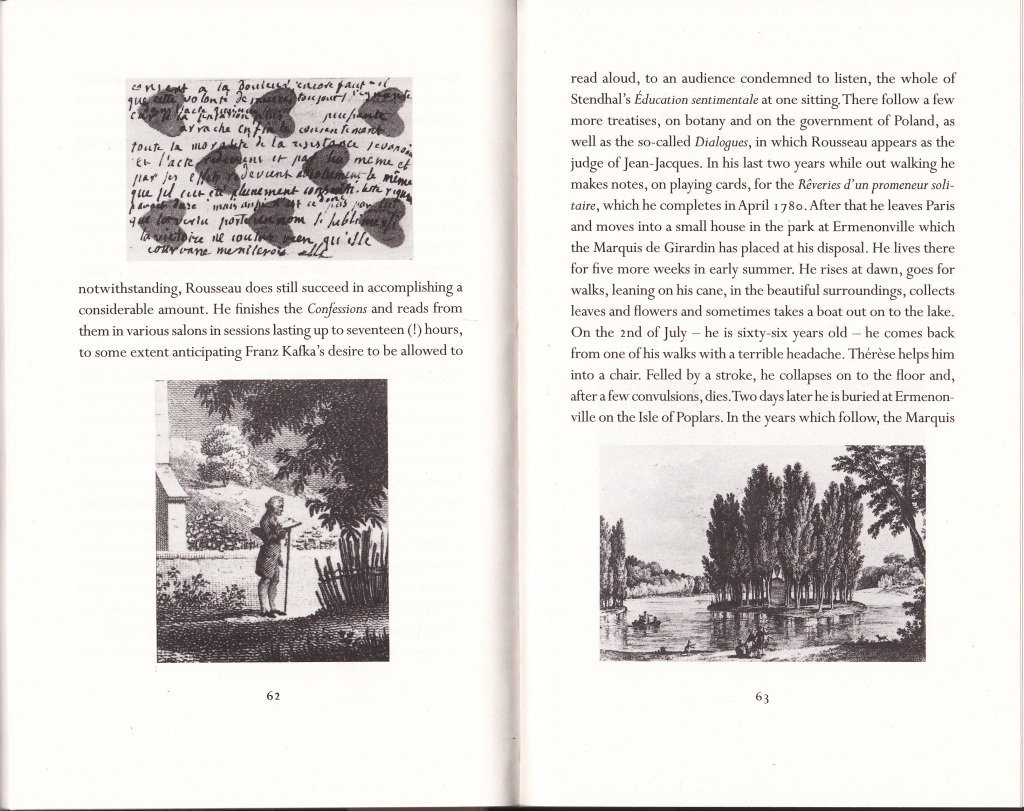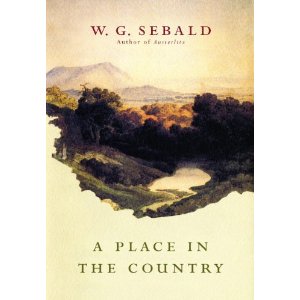 We have had to wait fifteen years for a publisher to decide to do an English translation of W.G. Sebald’s important book Logis in einem Landhaus, but A Place in the Country (Hamish Hamilton/Penguin, 2013), translated by Jo Catling is finally out – in England, at least (the American edition is a year away). Catling, who teaches at the University of East Anglia (where she was a colleague of Sebald), is an important scholar of Sebald and modern German literature, and is now becoming a key translator of his essays. A Place in the Country contains Sebald’s Foreword and the six essays that originally consisted Logis. In addition, Catling prefaces the book with her own helpful Introduction and unobtrusively adds some Translator’s Notes and a Bibliography at the back. Her Translator’s Notes make up for the lack of footnotes in Sebald’s original text, allowing the book to be more useful to general readers. Sebald clearly wanted to make a statement about the purpose of these essays by omitting “scholarly accoutrements,” as Catling calls them, and her decision to judiciously annotate the origins of phrases and other literary references in Sebald’s essays provides the anxious reader with the ability to satisfy one’s curiosity and perhaps do further reading. The Bibliography lists all of the works mentioned in the essays, along with their English translations, if any.
We have had to wait fifteen years for a publisher to decide to do an English translation of W.G. Sebald’s important book Logis in einem Landhaus, but A Place in the Country (Hamish Hamilton/Penguin, 2013), translated by Jo Catling is finally out – in England, at least (the American edition is a year away). Catling, who teaches at the University of East Anglia (where she was a colleague of Sebald), is an important scholar of Sebald and modern German literature, and is now becoming a key translator of his essays. A Place in the Country contains Sebald’s Foreword and the six essays that originally consisted Logis. In addition, Catling prefaces the book with her own helpful Introduction and unobtrusively adds some Translator’s Notes and a Bibliography at the back. Her Translator’s Notes make up for the lack of footnotes in Sebald’s original text, allowing the book to be more useful to general readers. Sebald clearly wanted to make a statement about the purpose of these essays by omitting “scholarly accoutrements,” as Catling calls them, and her decision to judiciously annotate the origins of phrases and other literary references in Sebald’s essays provides the anxious reader with the ability to satisfy one’s curiosity and perhaps do further reading. The Bibliography lists all of the works mentioned in the essays, along with their English translations, if any.
The only time that A Place in the Country comes up short is the way the publisher has dealt with the color illustrations that Sebald included with each essay, a decision undoubtedly based on economics. In Logis, the color plates are all on fold-out pages, permitting the reader to view the entire image with only the ghost of a crease in the middle. In A Place, the images are done as double-page spreads, forcing the center portion of each image into the binding. Hamilton’s choice of glossy paper probably results in more accurate reproductions, but I think this also causes the images to shout out their presence rather than be one with Sebald’s text, as is the case with the German version by Hanser. On the plus side, however, A Place in the Country restores a missing color plate to the very first essay on Hebel, a plate that Hanser mysteriously omitted in their hardcover edition of the book, although it appears in subsequent paperback editions.
Logis in einem Landhaus appeared in 1998, after the first three of Sebald’s four works of prose fiction – Schwindel. Gefühle (1990), Die Ausgewanderten (1992), and Die Ringe des Saturn: Eine Englische Wallfahrt (1995). In fact, Logis/A Place is closely related to Schwindel. Gefühle (Vertigo), which had chapters on Stendhal, Casanova, Kafka, and, tellingly, Sebald himself. Combined, these two books show us a Sebald deliberately creating the architecture for his own heritage as a writer. In another sense, A Place in the Country is a kind of shadow autobiography, with Sebald weaving his on personal and family history into the fabric of these six essays.
In his essay on Hebel (1760-1826) called “A Comet in the Heavens: A Piece for an Almanac, in honor of Johann Peter Hebel,” Sebald immediately establishes a personal, extra-literary connection with Hebel. Here’s Sebald explaining the attraction of Hebel’s Kalendergeschichten (Calender or Almanac Stories):
What always draws me back to Hebel is the completely coincidental fact that my grandfather…would every year buy a Kempter Calender, in which he would note, in his indelible pencil, the name days of his relatives and friends, the first frost, the first snowfall, the onset of the Föhn, thunderstorms, hailstorms and suchlike.
In fact, fourteen pages go by before Sebald manages to insert a single biographical fact about Hebel. Hebel, who was born before the French Revolution and the rise of Napoleon, becomes a touchstone for a more Edenic era of European history. “Even today,” Sebald writes, Hebel’s Almanac writing “constitutes for me a system in which…I would like still to imagine that everything is arranged for the best.” And: “Nowhere do I find the idea of a world in perfect equilibrium more vividly expressed than in what Hebel writes about the cultivation of fruit trees…” What Sebald admires in Hebel is “his unerring moral compass” at a time when the world, as Sebald sees it, was being radically transformed – and not for the better.
For a while, Hebel admired Napoleon and, like many others, felt that his wars had the “higher reason” of promoting equality and tolerance” across a new Europe. But he eventually came to see the unprecedented scale of waste and carnage that Napoleon’s armies wrought. Sebald refers at some length to Jean Dutourd’s “deliberately politically incorrect essai” of 1996*, in which he suggested that it was, in fact, the French Revolution and the Pan-European destruction of the traditional ruling houses that opened the door to “an ever-accelerating maelstrom of destruction.” Even while acknowledging that this was “written from the viewpoint of an unreformed monarchist,” Sebald is clearly drawn to a version of history that helps explain how “the new and terrifying Deutschland” arose from its own “smouldering ruins.”
…it is precisely the emancipation of the bourgeosie…which established the economic and philosophical prerequisites for the catastrophe capable of turning whole continents upside down…[and] also the doom-laden glimmering of a new age which, even as it dreams of humanity’s greatest possible happiness, begins to set in train its greatest possible misfortune.
Thus, Hebel’s Almanac writings become for Sebald a foreshadowing of Germany’s future and the Holocaust.
Possibly Hebel already had a sense, in 1812/13, that the fall of Napoleon and the rise of the German peoples signalled the beginning of a downward path which, once embarked upon, would not be easy to halt, and that history, from that point on, would amount to nothing other than the martyrology of mankind.
As we know from the opening section of Vertigo, the year 1813 played a crucial role in Sebald’s symbolic and almost superstitious use of the years 1813, 1913, and 2013. So it certainly seems fitting that A Place in the Country should be published in 2013.
* NOTE: A typographical error in A Place in the Country ascribes Dutourd’s essai (which is entitled Le feld-maréchal von Bonaparte : Considérations sur les causes de la grandeur des Français et de leur décadence) to 1966, when it was actually published by Flammarion in 1996.














